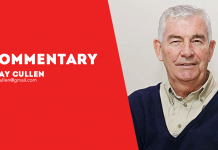
BY SHAY CULLEN
THERE are essentials of life that we all need nowadays: fresh air, food, water, clothes, shelter, health, electricity, and the Internet. The Internet is now an essential means of human interconnectivity and has become a blessing and a blight on human society depending on who and how it is used or abused. As you read these words, it is because they were sent to you over the Internet.
Every industry and most service organizations are almost totally dependent on computer technology that needs connectivity through the Internet. Almost all communication is now Internet-based: e-mail, voice, image and transmission of documents and information storage and dissemination. Conferences and meetings and educational classes are now mostly by Internet.
But there are vulnerabilities with this dependency. Hackers can steal data from government and corporations and hold them to ransom as happened to the Irish Health System and previously to the UK National Health Service (NHS), affecting thousands of patients. The Internet has replaced landline telephone by and large with the smart phone. There 5.7 billion mobile phones in the world today. Movies are being transmitted by live streaming; television will soon follow.
It all began when computer scientists sought ways to connect computers so they could communicate with each other over phone lines. It was in the 1970s when scientists Robert Kahn and Vinton Cerf developed a way for computers to interface and connect through their invention of the Transmission Control Protocol an d Internet Protocol or TCP/IP. In 1983, this technology was adopted by an existing but ineffective computer network system called Advanced Research Projects Agency Network (ARPANET).The TCP/IP protocol transformed it to an effective workable communications network.
Then other computer networks were developed and all joined together to form the Internet, a global communication network of computers. This enabled the growth of web pages where all kinds of informational content is available, known as the World Wide Web or The Web. A browser or search tool on a computer connected to the Internet can find any information. The content can be good or bad.
Another source of abuse is live streaming of illegal images and spreading hate speech, misinformation, and harassing people. The liability of the companies like Facebook, Twitter, and Google that enable the posting or accessing of information on their social media platforms is governed by a Provision of the US Communication Decency Act Section 230. It says, “No provider or user of an interactive computer service shall be treated as the publisher or speaker of any information provided by another information content provider.”
This means the Internet-based platforms cannot be held liable for anything posted on their pages or platforms. They are not publishers like a newspaper. They can allow all kinds of information, statements, articles, news videos and images to be posted there as an exercise of freedom of speech and they are not liable for the content. They make money by gathering the personal data of the people who use their platforms and sell it to advertisers. However, they are not allowed to invade privacy or allow hate speech or inflammatory racist posts or child abuse images.
This flow of information is enabled and made available by Telecommunications Corporations or Internet Server Providers (ISPs). The public pays them to be connected to the Internet. They are not liable for what passes through their servers but they should stop dangerous and illegal content like child abuse images. It like they own a building where the public gather in the lobby and the ISPs allow toxic poison to pass through day and night. The vilest abuse of the Internet is when it is used to share images of children being abused. The Internet Service Providers (ISPs) worldwide should be held responsible by law to install software on their servers to block all child abuse images.
In the UK, it is the NGO Internet Watch Foundation (IWF) that does this for the UK-based ISPs and share with many organizations worldwide the result of their work finding child abuse images. However, since all ISPs are connected through the Internet, all have a collective responsibility to install the blocking software and stop the child abuse images entering their severs.
If all used the existing blocking software, the evil can be greatly reduced if not eliminated. The IWF can’t do it all. The ISPs, at least, should sign on and join their service. The IWF can find many web pages and sites hosting child abuse images and remove them. IWF told this column, “Our approach has seen the percentage of child sexual abuse material (CSAM) content hosted in the UK decline from 18 percent in 1996 to less than 0.15 percent in 2019, making the UK a very hostile place to share CSAM content online.” How about the rest of the world? The ISPs everywhere should be doing this, too. IWF has shown the way.
Microsoft has developed effective softwares, PhotoDNA and VideoDNA, to do this and offers it free of charge. It is effectively used by Internet Watch Foundation. The ISPs everywhere should install this software. In the UK, Lord Raymond Hylton raised the issue in Parliament. A new law in the UK, Online Safety Bill, will establish “Duty of Care.” This will hold telecommunication corporations liable for any content that would harm users.
In the Philippines the law requires the ISPs to install the software since 2009 but they have resisted to do so and perhaps pay a small fine instead. This law is being reviewed. PLDT/Smart has recently signed up to get on the recipient list of the IWF. The IWF has identified more than 9,000 sites containing CSAM and all ISPs can now block them if they install the blocking software to do so.
But will they or is this just a public relations stunt? Microsoft has told this column that PLDT/Smart has not yet taken the Microsoft blocking software. So the challenge is out there for the ISPs to find a moral conscience, to obey existing laws and take voluntary action to protect children online. (preda.org)/PN

